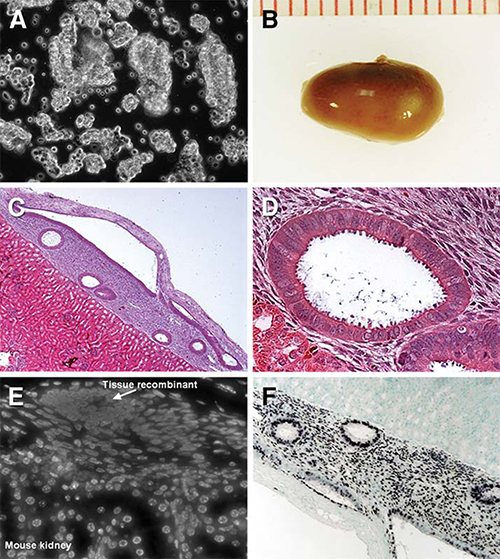
Human Endometrial Xenotransplants (Ref. 6)Drs. Jeffrey W. Pollard and Nanette Santoro. "Estrogen and Progesterone Regulation of Human Endometrial Cell Proliferation"
Central to the functioning of the uterus is the steroid hormone regulation of cell proliferation. In the epithelial cells estradiol-17ß (E2) stimulates cell division whereas progesterone (P4) inhibits this E2induced cell proliferation while at the same time preparing the epithelium for the reception of the blastocyst prior to implantation. Loss of control by these steroid hormones of uterine proliferation leads to benign diseases such as endometriosis and fibroids that in responsible for significant levels of infertility and morbidity in women as well as endometrial cancer that is the second most common cancer in women.
Our studies supported by the Center grant translate our group’s basic findings in rodent models of uterine function to the human. In mice we have defined two mechanisms of progesterone inhibition of E2-induceduterine epithelial cell proliferation. The first blocks the E2signaling through PI3 kinase pathway that leads to inactivation of Gsk-3b and the consequent coupling to the canonical cell cycle machinery through cyclin D1 nuclear localization. The second is via the inhibition of pre-replication licensing a pathway also activated by E2. In our studies supported by the SCCPIR grant we are using xenotransplants of human endometrium in immunocompromised mice in order to test whether similar mechanisms found in mice are operative in humans. In addition we are using bioinfomatic approaches to analyze sex steroid hormone regulated pathways in epithelial cells isolated from the human endometrium at different stages of the menstrual cycle. We are also studying the mechanism of action of selective estrogen and progesterone modulators that are in clinical use or in trials to prevent breast cancer or treat proliferative diseases. Overall our goals are to define mechanisms of estrogen and progesterone action to develop novel therapeutics to control uterine proliferative diseases in women and also to enhance fertility.
Relevant Publications:
- Niklaus, A., Pollard, J.W., (2006) Mining the Mouse Transcriptome of Receptive Endometrium Reveals Distinct Molecular Signatures for the Luminal and Glandular Epithelium. Endocrinology. 147: 3375-3390. (View pdf)
- Pan, H., Zhu, L., Deng, Y., Pollard, J.W., (2006) Microarray analysis of uterine epithelial gene expression during the implantation window in the mouse. Endocrinology: 147: 4904-4916. (View pdf)
- Pan, H., Deng,Y., Pollard, J.W., (2006) Progesterone blocks Estrogen-induced DNA Synthesis through the Inhibition of Replication Licensing. Proceedings of the National Academy of Sciences: 103: 14021-14026. (View pdf)
- Niklaus, A.L, Aubuchon, M., Zapantis, G., Li, P., Pollard, J.W.*, Santoro, N* (2007) Assessment of the Proliferative Status of Epithelial Cell Types in the Endometrium of Young and Menopausal Transition Women. Human Reproduction: 22, 1778-1788. (View pdf)
- Zhu, L., Pollard, J.W. (2007) Estradiol-17b Regulates Mouse Uterine Epithelial Cell Proliferation through Insulin like Growth Factor-1 signaling. Proceedings of the National Academy. 104: 15847-15851 (Winner of the Einstein Zondek award in Endocrinology) (View pdf)
- Polotsky, A.J., Zhu, L., Santoro, N., Pollard, J.W., (2009) Lithium Chloride Treatment Induces Epithelial Cell Proliferation in Xenografted Human Endometrium. Human Reproduction 2009. 24, 1960 - 1967. (View pdf)
- Kuokkanen, S,Chen, B, Benard L, Pollard, JW, Sant'Angelo, DB( 2009) Genomic Profiling of MicroRNAs and mRNAs Reveals HormonalRegulation in microRNA Expression inHuman Endometrium. Biology of Reproduction. ( In Press )